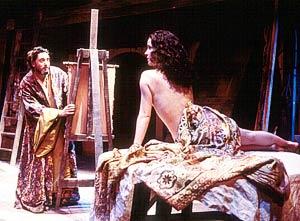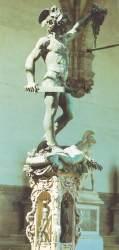SEARCH CurtainUp
REVIEWS
FEATURES
NEWS (Etcetera)
ADDRESS BOOKS
Broadway
Off-Broadway
BOOKS and CDs
OTHER PLACES
Berkshires
London
Los Angeles
Philadelphia
Elsewhere
QUOTES
On TKTS
LETTERS TO EDITOR
FILM
LINKS
MISCELLANEOUS
Free Updates
Masthead
NYC Weather
Cellini
|
What is this excess in your nature--- Pope Clement I don't know. I've had this rage since I was born. It creates and destroys at the same time --Cellini |

Reg Rogers and Jennifer Roszell
(Photo: Joan Marcus) |
Shanley, who calls New York "his Florence" is to be admired for the time and commitment he has brought to his first attempt at a more seriously intentioned play in a new to him genre. Equally praiseworthy is Reg Rogers for giving his actor's all to portraying the fiery Florentine with a mix of humor and passion. The satiric humor of both playwright and actor are the most entertaining parts of Cellini, and give it a certain saucy currency.
The popes, kings and dukes who were the tastemakers of the Renaissance and held the purse strings that controlled the artists' output weren't too different from producers and grant givers in the year 2001. Cellini's confrontation with Pope Clement (David Chandler) is a priceless interchange during which the Clement asks Cellini to explain his ambition. The Pope, himself the father of a bastard (shrugged off by Cellini with "What else would a Pope to have?"), grants Cellini a pardon. That pardon encompasses a murder in defense of his brother and another committed in outrage against a goldsmith who considered himself his equal. Who says Bill Clinton went overboard in pardoning the escaped fugitive billionaire Mark Rich? The pardon makes Cellini the Pope's artist in residence. He must, however, content himself with creating gold coins instead of the giant sculpture of his ambitious dreams.

Perseus and Medus
|
The twenty-seven characters, played by eight actors, move from the platforms and balconies to the main level of the high domed, two-level set which is sparsely furnished but evocative of church or artist's studio and, at one point, the prison dungeon where Cellini spent 200 harrowing days ( the lighting, excellent throughout, is particularly effective here). At times a group stands on the platform chanting like a Greek chorus. Everyone is stylishly and lavishly dressed for the period, with a prescient bow to modernity via Reg Rogers' trim black leather pants. And say what you will about the faux Florentine and French accents, these actually go with the comic mirror the irrepressible comic turned art historian holds up to us. (If you don't believe me, note that the able dialect coach Deborah Hecht is listed in the program).
To bolster Cellini's reputation in the art of amour, we have his model and mistress (Jennifer Roszell) emerge from a cloth covering a work table wearing nothing but her smooth skin. Beautiful as she is, Ms. Roszell's robing and disrobing comes often enough to be too much of a good thing. This minor quibble brings us to the major ones, and there are, especially in the overlong second act, enough to draw up a list.
- The small cast does journeyman work playing multiple roles. Except for Daniel Oreskes whose Duke of Florence is a gem, Shanley, who also directs, has encouraged actorly excesses elsewhere, especially in the case of Reg Rogers' melodramatic ecstasy of excitement during the final firing up of the masterpiece.
- Typical of all too many author-directors, Shanley has also allowed some of the second act scenes to drag on to the point that has you stealing peeks at your watch. The other characters, except for the already mentioned Duke of Florence, are not so much secondary to the main man but skimpily developed. Ms. Roszell's model has plenty of flesh showing but her character is all bare bones. The young boy model (Lucas Papaelias) is again a character in search of a stronger place in the story. Also wasted is the Mozart-Salieri angle involving Bandinello (John Gould Rubin), a jealous artist who tries to undermine Cellini to the Duke, and, in one completely superfluous scene, almost becomes Cellini's third murder victim.
- Finally, there is the big climactic scene when Cellini, not at all sure he can bring off the intricate process of casting the Perseus wax model in bronze, directs his apprentices to pull it safely out of the fire. That coup-de-stagecraft blazing hole in the ground (there's even a real whiff of the process for authenticity) and the ensemble noisily working away almost makes you expect to have them break out singing "Out Of the Fire" à la Frank Wildhorn. But all this stagy excitement leaves the audience feeling shut out from the final triumph -- like watching someone go through labor but not being allowed to see the baby's entry into the world.
As it is Cellini isn't a bad play but to be a really good one it needs a director other than the author to reign in its length and the more egregiously overwrought performances. That would free Shanley to go back to his word processor to make his lesser characters more fully rounded and interesting. It could be that these characters are somewhere in his notes and became victim of what can sometimes be a too long and involved process of writing and rewriting. Whatever, the cause or the cure, the present production still falls short of being the Perseus of Shanley's career.
|
CELLINI Written and Directed by John Patrick Shanley Cast: Lisa Bansavage, David Chandler, Daniel Oreskes, Lucas Papaelias, Gary Perez, Richar Russell Ramos, Reg Rogers, Jennifer Roszell, John Gould Rubin Set Design: Martin Pakledinaz Lighting Design: Brian Nason Costume Design: Adrianne Lobel Sound Design: David Van Tieghem Running Time: 2 hours, plus 15-minute intermission Second Stage, 307 W. 43rd St. (8th/9th AV), 246-4422 Tue, Thu - Sat at 8pm; Wed at 7pm; Wed & Sat at 2pm; Sun at 3pm-- $30 - $50. 1/24/01-3/04/01; opening 2/12/01. Reviewed by Elyse Sommer based on 2/14/01 performance |


